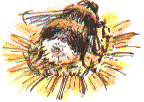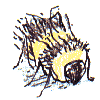 |
BumblebeeThursday 9th August 2001, West Yorkshire |
![]()
![]()
![]()
![]()
![]()
![]() This Month
Rocks
History
Workshop
Links
Home Page
This Month
Rocks
History
Workshop
Links
Home Page
![]()




BUMBLEBEES survive as far north as the Arctic Circle. They're on the wing earlier and later in the day than the honey bee. The large queen bees that we saw in the spring are mostly confined to their nests now and it's more likely to be workers (sterile females) that we see. Most bumblebees make a rather untidy nest amongst the dried grasses in an old mouse hole.
 This bumble bee, which I found dead on the lawn not far from the marjoram, which is in flower and attracting lots of bees and butterflies at the moment. It is 15 millimetres long - just over half an inch. The two bands of ochre and the off-white tail make me go for Bombus terrestris as the species, or possibly Bombus lucorum. Although one of the English names for this species is the Buff-tailed Bumblebee it's the queen who has the yellowish tail, and, by the way, that is only in Britain; they have white tails on the continent.
This bumble bee, which I found dead on the lawn not far from the marjoram, which is in flower and attracting lots of bees and butterflies at the moment. It is 15 millimetres long - just over half an inch. The two bands of ochre and the off-white tail make me go for Bombus terrestris as the species, or possibly Bombus lucorum. Although one of the English names for this species is the Buff-tailed Bumblebee it's the queen who has the yellowish tail, and, by the way, that is only in Britain; they have white tails on the continent. The long antennae make me wonder if this is a male. It does have long hairs on its back legs - these are the so-called pollen baskets - but, looking through a magnifying glass I can't see a trace of pollen on them. I guess that the males don't contribute to the food stores of the colony by collecting pollen.
The long antennae make me wonder if this is a male. It does have long hairs on its back legs - these are the so-called pollen baskets - but, looking through a magnifying glass I can't see a trace of pollen on them. I guess that the males don't contribute to the food stores of the colony by collecting pollen.Related Links
The Bumblebee Pages, compiled by L. Smith, include a guide to six species common in north east Scotland.Alphabetical list of Bombus species, Natural History Museum, London.
![]()
Richard Bell,
wildlife illustrator
E-mail; 'richard@willowisland.co.uk'
![]() Next page
Previous page
This day last year
This month
Nature Diary
Home Page
Next page
Previous page
This day last year
This month
Nature Diary
Home Page
![]()